#raid0
Explore tagged Tumblr posts
Text
what if my system partition was 3 nvme drives in btrfs raid0. zoom zoom?
5 notes
·
View notes
Text
will be replacing my 3 old 4tb disk 12tb raid0 with a 2 new 8tb disk 16tb raid0 to increase capacity & reduce fragility (& turn the 4tb disks into individual offline annex backups)
4 notes
·
View notes
Quote
プロフィール 33歳。女。発達障害(自閉スペクトラム症・ADHD)と双極性障害2型。ただし、この話に理解のある彼くんは登場しないので、安心して読んでほしい。家族構成 家族は父のみ。母は自殺した。兄弟はいない。 父は、一流企業を定年退職した後、趣味で一流大学や一流大学院に通っている。私なんかを養ってくれている。 しかし私が、私を含む社会的弱者、例えばホームレスなどに同情的な発言をしてしまうと、「お前は馬鹿だからパヨクに騙されてるんだ!」と怒鳴り散らす。選挙になると、私を選挙会場に連れていき、この候補に投票しろと命令する。 母は、私が発達障害で、理想的な娘ではなかったため、統合失調症になり、自殺した。母には毎日、よく殴られ、よく蹴られていた。 悲しかったのは、高3の夏に、両親が、私が飼っていた水色のマメルリハインコを殺してしまったことだ。鳥籠を室外機の上に置いて蒸し焼きにした。同じ高校のみんなが旧帝大の医学部を目指している中、MARCHの文系でさえ危うかった私を勉強させるためだと言っていた。日付だって覚えている。2008年7月19日だ。それまでは、親の人間性を信じていた。親に殴られたり蹴られたり死ねと言われたり自殺しろと言われたりしても、いくらなんでも小さな小鳥の命まで粗末に扱うとは思っていなかった。就労移行支援と基本情報技術者 B型作業所に通っていたが、去年の5月から就労移行支援に通うことになった。職員に、障害者雇用で働くには何が何でも週5フルタイムで動かなければいけないと言われて、夜眠れなくてふらふらでも、レッドブルやモンスターエナジーなどのエナジードリンクを何本も飲んで通ってきた。 月〜金曜日は就労移行支援、土曜日は基本情報技術者の講座に通った。 去年の10月に基本情報技術者には受かった。今はJava SE Bronzeの勉強をしている。肺の腫瘍 実は、去年の6月頃から咳がひどく、咳の勢いで吐いてしまうので、去年11月にようやく病院に行った。すると、町の内科、市民病院、大学病院と、病院がどんどんランクアップし、肺の腫瘍が見つかり、全身麻酔で肺の腫瘍を切除されるはめになってしまった。2月下旬に良性か悪性かの告知がある。 何がいけなかったのかと考えれば、全部がまずかった気がして、どこから手を付けたらいいのか分からなくなる。良性でも悪性でも、今後どう動くか考えなければならない。今後 良性だったら、このまま就活をがんばって、障害者雇用でどこかの企業に雇われること。障害者雇用の相場を考えるとかなり無茶な話だが、手取り14万円以上もらうこと。東京都の精神障害者の生活保護費がそれくらいと聞いた。それさえあれば生活できる。 悪性だったら、どうしようかな、生活保護でがんの治療って受けられるのだろうか。追記(02/08/15:30) たくさんの反応ありがとう。力になった。 病院には早く行った方が良かった。幸い、PET-CTの結果、全く転移はしていないそうだ。 基本情報のこと、認めてもらえて嬉しい。本番でRAID0とRAID1を間違えるという初歩的なミスをしてしまったけど、なんとか合格できたよ。 2年前に別の増田に書いた、超有能な相談支援専門員とはまだ繋がっているし、今の就労移行の職員も、親身に話を聞いてくれる。また、オンラインカウンセリングでいい公認心理師を見つけて、定期的に話を聞いてもらっている。 あと、精神障害でも障害基礎年金をもらいながら働けるの?身体や知的の人だけだと思ってた。本当なら、生きることが完全に怖くなくなるなぁ。
無理していたら腫瘍ができた(追記あり)
3 notes
·
View notes
Text
Pro-tip: Get a small, high resilience SSD like an Intel Optane one or, if you can't travel to the end of the world to withdraw one from the Fountain of Youth, any SLC drive (I think some of Sabrent's lower capacity ones are SLC?) and use it as a boot drive, SATA is fine since it's unlikely to see very many reads or writes that would benefit from more than 6 gigabits of throughput. It will probably not fail within your lifetime. Then, get a large (500-960 gig) NVMe SSD for storing games and other stuff that benefits from the speed. And then get one or more HDDs with terabytes of capacity for storing everything else. Books, movies, porn, television shows, anything that doesn't need insane reads or writes and can function just fine on a very slow drive. Ideally, you wanna get pairs of drives, and put each of them in a RAID0 configuration, so even if one fails, the other one will LIVE!!! and can be used to build back the data onto a new drive.
Of course if your case doesn't have space for that many drives, you can buy external enclosures that can connect to your PC via Thunderbolt or USB. And if you don't wanna spend tons of money on one of those, you can always just buy a super old case with tons of drive bays, slap a bunch of drives in there along with a 30 dollar Thermaltake Smart power supply, and just add a SATA HBA add-in card to your main PC via a PCIe slot, and just plug all the drives into that. Though if you're going that far, then in a few more steps you can honestly just turn the darn thing into a NAS (network-attached storage) that would let you access your files from potentially anywhere, which is cool
its called the D: drive because you look at how much space is left on it and you go "D:"
89K notes
·
View notes
Text

LincPlus è un'azienda cinese, con base a Shenzhen, nata nel 2018 da un appassionato gruppo di amanti della tecnologia, in pochi anni è riuscita ad espandersi a macchia d'olio nei mercati europei ed americani, conquistando sempre più utenti nel mondo. Di base è specializzata in due linee di prodotti: LincStudio e LincStation. Il primo è un tablet all-in-one, noi invece vi proponiamo la recensione di LincStation N1, un NAS a 6-bay, ovvero con 6 slot differenti dove posizionare i dischi di memoria, perfetto per l'utenza domestica, ma non solo. Scopriamolo con la recensione completa. Design e Estetica Il prodotto presenta dimensioni relativamente ridotte, per gli standard del settore, ha una form factor che ricorda più un decoder o un lettore di videocassette, è difatti dotato di una forma allungata, sufficientemente sottile, con peso di 800 grammi. Nello specifico, le dimensioni sono di 14,99 x 20,83 centimetri, con uno spessore che non va oltre i 3,81 cm. L'eleganza regna da padrona, con il dualismo che l'azienda è stata in grado di creare sul prodotto: nella parte superiore troviamo un "coperchio" realizzato in plastica, di colorazione nera, con finitura opaca, al cui centro viene indicato il nome del dispositivo. Ad appoggiare sulla superficie inferiore ci pensa una parte metallica, con finitura spazzolata, molto resistente e dal design sicuramente ammirevole, che innalza notevolmente il livello qualitativo del prodotto. All'interno della confezione è possibile trovare tutto il necessario per il suo corretto funzionamento, oltre al NAS stesso, sono presenti accessori di vario genere (per facilitare il montaggio degli hard disk), oltre al cavo di alimentazione (data l'assenza di una batteria integrata), l'alimentatore vero e proprio ed un manuale di istruzioni. Hardware e Specifiche LincStation N1, come anticipato, è un NAS classico con licenza Unraid, che prevede la possibilità di virtualizzare qualsiasi sistema operativo, sia esso Android, Linux o Windows, così da rendere il prodotto non solo il NAS di casa, ma anche una sorta di cloud personale o home server. A tessere le fila è presente processore Intel Celeron N5105, che viene affiancato da 16GB di RAM, nonché da una connettività virtuale sufficientemente fornita, come WiFi 6 dual band e bluetooth 5.2. Uno dei suoi più grandi pregi riguarda la possibilità di installare un numero particolarmente elevato di hard disk, è infatti possibile raggiungere un massimo di 48TB di spazio di archiviazione, sfruttando i 4 slot per M.2 NVMe SSD (massimo 8TB singolarmente) presenti anteriormente e superiormente, a cui si aggiungono altri 2 slot Sata3 da massimo 8TB, per un totale, come anticipato, di 64TB. La flessibilità è la parola d'ordine, proprio perché l'utente si ritrova a poter variare il setup a proprio piacimento, senza dover sottostare a vincoli particolari, ma anche riuscendo così a raggiungere una capacità complessiva particolarmente abbondante (fino a 10 milioni di foto, 15 milioni di file e 1 milione di video in HD), e più che sufficiente per un ambiente domestico, o professionali di piccole/medie dimensioni. Il salvataggio dei dati è sicuro ed affidabile, con il pieno supporto a tutti i livelli RAID conosciuti (RAID0 fino a RAID6). L'installazione è semplicissima ed alla portata di tutti i consumatori, infatti per quanto riguarda gli slot anteriori basta rimuovere la placchetta frontale per poi andare ad inserirli manualmente. Discorso simile per gli slot posteriori, non sono richieste abilità particolari. Sono compatibili tutti gli hard disk o SSD da 2,5" con interfaccia sata3, o gli NVME M.2 2280, sottolineando la limitazione nello spessore dell'alloggiamento: il disco non deve essere superiore a 9,5 millimetri. Una volta acceso, LincStation N1 risulta essere particolarmente silenzioso (anche perché permette l'installazione di tutti SSD, che tecnicamente sono più silenziosi dei classici dischi ottici), grazie alla presenza di un sistema di raffreddamento efficiente e performante, capace di mantenere la temperatura (quando in standby), sempre all'incirca sui 50 gradi celsius. Durante questa fase, le ventole non girano (o comunque pochissimo), limitandone moltissimo la rumorosità; da notare che la velocità di rotazione è direttamente proporzionale alla temperatura e all'operatività, per cercare sempre di bilanciare performance e silenzio. Connettività e Prestazioni Smontando la parte anteriore, tramite la quale si accede ai due slot, possiamo notare due peculiarità: la presenza di una striscia LED, che crea atmosfera ed accresce ulteriormente l'appeal estetico, oltre ad una porta USB-C. Spostando l'attenzione postderiormente, invece, si apre una buona dotazione di connettori fisici, al netto della DC port 12V/5A, che ci ricorda la necessità di collegare fisicamente il NAS ad una presa di corrente per il suo funzionamento, sono presenti due porte USB-A 3.0, una ehternet RJ45 a 2,5Gbps, per una connessione dati velocissima, oltre ad una porta HDMI classica con trasmissione dai in 4K a 60fps. La sua natura di media center la notiamo proprio in quest'ultima connessione, il 4K a 60fps, ovvero permette di collegare direttamente il NAS ad un monitor o un televisore, così da riuscire a trasmettere contenuti video alla massima qualità, senza perdite di alcun tipo. La connessione alla rete può avvenire sia tramite la porta ethernet fino a 2.5Gbps (quindi velocissima), che con il WiFi 6 dual-band. Il sistema operativo è semplice ed intuitivo, molto facile da utilizzare anche per gli utenti meno esperti, offre alcune funzionalità particolarmente interessanti: backup automatico delle immagini direttamente dal telefono in un qualsiasi momento, gestione intelligente dei file, backup centralizzato, con i dati ricevuti da varie fonti, possibilità di salvare (e ricevere) dati dal cloud, oppure di sincronizzarli da qualsiasi sorgente, siano altri NAS, computer con sistema operativo Windows, dispositivi mobile e Apple Mac. Nel complesso ne siamo rimasti piacevolmente soddisfatti, proprio perché è risultato essere un sistema operativo alla mano, intuitivo e facile da utilizzare. Conclusioni Arrivati a questo punto è il momento di trarre le conclusioni su tutto quanto abbiamo raccontato nel corso della recensione. LincStation N1 può essere una validissima alternativa ai tanti sistemi NAS che potete trovare sul mercato, parliamo ad esempio dei quotati Synology, TerraMaster, QNAP e similari, che riesce a distinguersi in primis con un'estetica davvero unica nel suo genere. Il prodotto è incredibilmente elegante, robusto ed affidabile, presenta questo form factor da videoregistratore di una volta, da utilizzare sdraiato e non in verticale, capace di soddisfare le esigenze anche dell'utente più preciso, ma allo stesso tempo di avere dimensioni relativamente ridotte, tanto da risultare essere quasi portatile. Inutile dire che la presenza di 6 slot di archiviazione (6-bay), siano uno dei punti forti di questo dispositivo, la possibilità di intallare SSD rende l'accesso ai dati decisamente più rapido, la capacità di 48TB è molto buona e soddisfacente, con manutenzione quasi ridotta al imino e rapido accesso ai singoli dischi. In ultimo non ci resta che parlare della connettività, sicuramente ben fornita, con il plus rappresentato dal connettore fisico HDMI presente nella parte posteriore per il collegamento diretto al televisore, oppure della porta ethernet fino a 2,5GBps, per un accesso ai dati ancora più rapido. Il sistema operativo è altrettanto versatile, adatto alla maggior parte degli utilizzi, con buonissime possibilità di personalizzazione, e capacità di adattasi alle singole esigenze del consumatore, sia esso poco esperto, che conoscitore approfondito del settore. LincStation N1 viene commercializzato ad un prezzo di listino di��399 euro, una cifra che a conti fatti è decisamente più bassa di tutti i diretti concorrenti, poiché al giorno d'oggi con questa spesa in media si acquista un NAS 2-bay con spesso neanche il supporto agli SSD o con il modulo WiFi. L'acquisto può essere completato direttamente su Amazon, con consegna a domicilio in tempi brevissimi, e la certezza di poter abbracciare senza alcun problema la solita ottima garanzia legale della durata di 24 mesi, la quale copre ogni difetto di fabbrica che l'utente potrebbe eventualmente riscontrare in fase di utilizzo. Altre informazioni sul prodotto disponibili sul sito ufficiale. Read the full article
0 notes
Video
youtube
TrueNAS Scale Server 2025 24TB Raid6 (Boot in Raid0 Mirror)
0 notes
Text
備忘録/SSDが突然駄目になり色々直した話/mac
皆様こまめなバックアップを取っていますか?
macの方はTime Machineで空いたHDDなりSSDにバックアップを取ることが可能です。除外するフォルダも選べるので大きすぎたり不必要なものをバックアップから除くこともできます。音源って膨大なんで除いちゃっても…いいか…←この怠惰が後で痛い
最初に構成をご説明しておくと
Macintosh HD(OS)
内蔵PCIeカードSSD(mac proにカショっと刺すカード型SSD、1TBx4のRAID0)←これが故障
バックアップ用外付けSSD(HDDの方がいいらしい)
音源やライブラリ→PCIeカード
アプリやVSTなど→Macintosh HD(推奨のまま)
となっています。アプリ以外の音源やライブラリーを外付けに保存することは各製品問題ないようですがKontakt等のNIのライブラリーは別の音源と一緒にしないことを念押ししています
大容量のデータとなるため、内蔵ドライブの空き容量が足らない場合などには外部ドライブに設定していただくことが可能ですが、他のロケーションと同じ場所に設定されないようご注意ください。(ヘルプより引用)
あ…
先んじてお詫び申し上げたいのですが、備忘録のくせに何一つスクショを撮っていません…本当に申し訳ございません。
症状
制作中のAbletonのプロジェクトを立ち上げるとPCIeカードSSDが落ちる(差し直しかシャットダウン→起動で戻る。再起動は戻らない)
時間経過で落ちる(5-10分ほど?ふっと落ちる)
一部ファイルのコピーが完了しない(不明なエラー)
ある日突然シャットダウンしていたPCを立ち上げて(たまにはシャットダウンした方が良いかなと思い)、いつものようにAbleton Live12でプロジェクトを開いた所、見慣れないエラーが表示されました。
ここでスクショを取るべきなんですけどなんで撮ってないんですか??(「mp3が出力できないよ〜という内容だった気がします」というエラーが表示された後、なんと音源を入れている内蔵PCIeカードSSDがアンマウントされていました
えぇ…
PCの不調は再起動で直るとばあちゃんが言っていたので再起動します。がマウントされず、差し直してマウントされても時間経過で落ちるようになりました。その間のFinderでデータのコピーなどはできるので大事なプロジェクトを急いでコピーします
コラ〜〜〜!あんまり不安定なSSDに刺激与えちゃだめでしょ〜!
その通りなんですけど、仮に業者の方に修理していただくとしてPCIeカードなんてよく分からないものを修理できるのか、ネットで調べてもあまり信用ならない安心できない。それにSSD、HDDは壊れるものです。特にSSDは書き込み回数に制限があるのでいつ寿命を迎えてもおかしくない
迎えたこと無いですけど!
勝手にアンマウントされた後ディスクユーティリティを確認すると4つあるディスクのうち一つが不明となっていました。RAID0ストライピングという速さのために防御を捨てたストライカー型なので一つ壊れたら駄目だそうです。でも最初だけは読めるんだよなぁなんだろうなぁ
直そうとやったこと
PCIeカードを指す場所を変える(数分伸びたような気がするが改善なし)
マウント中にFirst aid(問題なしと表示される→その後落ちる)
Abletonのエラーログの確認(SSDが落ちてwavがないよ〜と言い出す以外は良好?ログの読み方がよく分からなかった)
アクセス権の確認(読めない〜と悩んでいる?と仮定しアクセス権を修正、効果なし)
考えうる原因
NIライブラリーを他の音源と一緒にしてしまっていたことによる事故?
セキュリティアップデートが入り何かが変わってしまった?
寿命?
しなかったこと
復旧ソフト、および復旧業者の利用
ひぃ〜ん
色々行っても良くなる兆候が見られなかったので、幸い数分だけマウントできること、バックアップ用SSDに音源ライブラリ以外のデータをTime Machineで保存していたことにより諦めて新規SSDを購入して音源を入れ直すことにしました
新SSD購入後
購入したSSDはこちら
えこれ4TBなのと思う小ささ。内臓はもうMac proをパカっと開けることがもうたいそう大変そうなのでやめました。せっかくカスタマイズの幅がすごいチーズおろし器Mac Proなのに…結局外付けSSDにするんだ…へぇ
Native Access
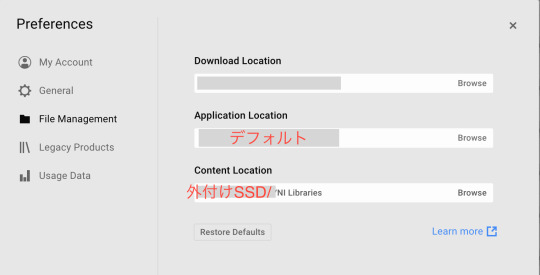
Time Machineから旧SSDのデータが無事復元できたようなので音源をインストールします。Komplete14を持っているのでNative Access経由で再インストール。フォルダはヘルプにあったNI Librariesという名前にして他の音源とは隔離しています
NIライブラリーが原因かどうかは分からないのですが頻繁にKontaktのコンタクトが切れるので怪しんではいます。でもいい音源。アリシアキーズ好き
Wavesやiztopeのバンドルも入れなきゃかな〜と思っていたらそれは本体にあるもので良いようで再インストールの必要はなさそうでした。やったね
NI製品の再インストールで気をつけること
フォーマットをAPFSにする(大文字/小文字を区別はNG!Battery君が困惑する。「探しているものはWAVよ。あなたのはwav」おこ)
Native Accessでフォルダのリンクと繋がっているので場所を変更した際はNative Accessも確認する
Native Accessのファイヤーウォールを外部からの接続を許可にしておく(ログインできない理由だいたいそれ)
Kontaktライブラリに表示されない時は一度再起動してみる
昔のプロジェクトを開くと昔のパスが残って「音源ないよ〜」と言われることがある。researchが必要。
Abletonのプロジェクトの音源再リンク
これで戻りました
全てはパスで繋がっているのでそのパスを再配置しただけです。今のところそれで問題なく復帰しました。おそらく旧SSDと同じ名前にしていたらそれも必要なかったかもしれませんが、整理を兼ねて直しました
旧PCIeカードSSDその後
新SSDの移行が問題なさそうだったのでフォーマット(消去)しました。復元も無駄だったのでどうかなと思いましたが何事もなくフォーマットが終わり何事もなくマウントされています。試しに1TBx2をREID0にして音源を含めた全てのバックアップディスクに回してみましたが不安になるくらい普通に終わりました
故障した原因ですが少なくとも寿命ではなくシステム障害だったのかなと思います。SSDにあまり詳しくないので再フォーマットしてまた使う使い方が問題ないかどうかはわかりません。あくまで自己責任で
ということで、4oのストレージが合計8TBになりました。ちゃんちゃん
1 note
·
View note
Text
5/30木
在宅勤務。頭痛なし。関西ツアーの出発日から早くも1週間! びつくり。 映像バックアップ用のRAIDのHDDを入れ替え。1年ちょいで6TB。RAID0にしてるので×2。

毎週楽しみにして見ているNHK「世界サブカルチャー史 欲望の系譜 シリーズ4 21世紀の地政学」、第一回「アイドル編」、第二回「ヒップホップ編」と来て今放送されているのは第三回「ポップス編」。文化の歴史を30分に凝縮して俯瞰できるのがすごく面白い。ポップス=大衆音楽編は、ビートルズからスタートして日本語ロック論争→筒美京平→小室サウンドと。今検索したら、元々BSプレミアム4Kで90分で放送されたものをEテレで30分×3回にして放送してるみたい。そしてこのあと第8回まであると。
関西ツアー中に進めようと思っていたe-U-n編集、やっぱりツアー中は進められず本日作業再開。坂本さんMIXの音源を当てて、他のMIXやエアーの音となじませる。あとエンドクレジットの調整。 夜の早い時間、眠くなったので一度寝て、再度起きたら頭ぼーっとしたままでそのうち頭痛酷くなって服薬して就寝。
0 notes
Text
AORUS Storage Manager
Софтина для объединение в программный RAID0 https://www.usbdev.ru/files/gigabyte/aorusstoragemanager/
0 notes
Text
External Bogus M.2 NVMe SSD With MicroSD secrets

The user of the computer is dissatisfied with the performance of the low-cost external M.2 NVMe SSD that they purchased, and because the device’s transfer rates were so bad, the user chooses to have a look inside the drive case that is linked by USB Type-C. The user’s computer is connected to the drive by means of a cable that has a Type-C connector.
M.2 NVMe SSD alternatives
As soon as they learned that the half-length PCB had two microSD cards, a “ancient” controller, and a connection that was wired for USB 2.0 speeds, they had every reason in the world to believe that their unhappiness was warranted. According to the findings of research that was carried out , these microSD card “M.2 NVMe SSDs” have already started to become available for purchase in stores.
It would appear that the dissatisfied Chinese internet user portrayed in the study was caught aback by the information that low-priced, no-name items purchased from dubious online marketplaces may be phony or fake. It appears that the things were acquired from a market located in China that is accessible online.
People continue to fall prey to items that are offered by marketplaces where everything goes for prices that are too good to be true, despite the fact that they have been made aware of a great number of warnings, heard a great number of horror stories, and demonstrated superior judgment. This is because people continue to be enticed to products that are supplied by marketplaces where anything goes for prices that are too good to be true.
The performance of the brand new 512 GB external M.2 NVMe SSD owned by an internet user who preferred to remain anonymous appeared to provide performance that was not even comparable to that of an external hard drive. Because of this, the internet user started developing some apprehensions regarding the item. After some consideration, he came to the realization that it would be most beneficial to take the casing off of the portable drive.
How to identify Fake M.2 NVMe SSD
The image on top reveals that the internal drive makes use of a pair of MicroSD slots, which are then loaded with TF cards. These slots may also accommodate SD cards. In the picture, you can see this process in action. We are not aware of the memory card’s technical specifications, such as its speeds, capacities, or how it was set; we are not privy to this information.
If the storage capacity of any of the cards was less than 256 gigabytes apiece, there is a possibility that the drive controller firmware might deceive the user regarding the capacity of the cards to store data. Con artists frequently employ methods such as the one being discussed here.
High-performance M.2 NVMe SSD
After further research, it was discovered that the printed circuit board (PCB) that is green in color and housing the small controller chip had a highly outdated layout. In addition, the wiring of current USB-C ports was solely designed to support the data transmission performance of USB 2.0 devices because it was the only purpose for which they were intended.
The findings of the research indicate that a person whose external M.2 NVMe SSD was taken and replaced with a fake would have noticed read rates on the device that were no better than one hundred megabytes per second at best. Came to the conclusion that the write speeds would be reported in the tens of megabytes per second range, unless the two MicroSD cards were configured in RAID0, which was an extremely unlikely scenario. In such scenario, the write rates would be evaluated somewhere in the neighborhood of hundreds of gigabytes per second.
Fast and affordable M.2 NVMe SSD
Online markets that do not have a good reputation everywhere in the world make it simple to acquire electronic devices that are false, fraudulent, poorly labeled, inappropriately advertised, and even occasionally harmful. This makes it easier to commit identity theft or financial fraud.
Because of so many different aspects, it could be tough to find these things. (Particularly interesting fake products and audacious scams sometimes make the pages of sites like ours). Stick with brands and companies that you are already familiar with and know you can trust, be suspicious of reported deals from sources that you don’t know as well, and most importantly, apply your common sense.
0 notes
Link
Based on Core i5-12650H Minisforum, known primarily for its mini-PCs, has released its first standalone motherboard. And this board is very unusual. [caption id="attachment_53260" align="aligncenter" width="780"] Minisforum Eyertec AD650i[/caption] Mini-ITX motherboard that allows you to install five drives. Minisforum Eyertec AD650i introduced The model is called Eyertec AD650i. This is a Mini-ITX board with a soldered CPU, but it has its own MXM board, which allows you to install three M.2 SSDs with a PCIe 3.0 interface. The expansion card supports a range of RAID configurations, including RAID0, RAID1, and RAID5, to create a compact home server. In addition, the motherboard itself has two SATA connectors for installing additional drives. The company had to sacrifice a PCIe x16 slot for a graphics card, so you have to be content with an integrated solution. By the way, it is based on a mobile CPU Intel Core i5-12650H. There is also room for two RAM modules. In China, they are asking $354 for a new product.
#AD650i#compact_PC#Computer_Technology#computing#desktop_computer#Eyertec_AD650i#mini_desktop#mini_pc#Minisforum#Minisforum_PC#PC_Hardware#small_form_factor_PC
0 notes
Photo

🚀 Vuoi elevare il tuo sistema di archiviazione al livello successivo? 😮 Confuso tra le configurazioni RAID 0, 1, 5, 6, 10 e JBOD? 🤔 Noi di G Tech Group abbiamo preparato una guida dettagliata che spiega le differenze tra queste configurazioni! 📘 ✅ Scopri la velocità di RAID 0 ✅ Esplora la sicurezza di RAID 1 ✅ Trova l'equilibrio con RAID 5 e 6 ✅ Massimizza la capacità con JBOD Dai un'occhiata al nostro articolo e fai la scelta giusta per il tuo business! 💼👩💼👨💼 👉 https://gtechgroup.it/raid-0-1-5-6-10-jbod-spieghiamo-le-differenze-tra-le-configurazioni/ 🎯 #RAID #ConfigurazioniRAID #RAID0 #RAID1 #RAID5 #RAID6 #RAID10 #JBOD #Sicurezza #Prestazioni #Velocità #Capacità #Archiviazione #GuidaRAID #Tecnologia #Business #IT #GTechGroup #HelpMePost #SoluzioniIT #Sistema #Hardware Questo post è stato pubblicato con #HelpMePost, provalo anche tu su helpmepost.com! 🚀
0 notes
Video
tumblr
I took four 8GB flash drives, split each of them into two 4GB partitions, then combined one partition from each into a RAID 0 (stripe) configuration.
The read/write speed of a RAID made of flash drives isn’t much better than a flash drive in it’s default configuration, so this isn’t ideal for a permanently mounted volume (aka don’t bother trying to run large programs/games from it).
What this IS useful for, however, is hiding sensitive data. By having each drive split into two partitions, the Avatar State Drive is disguised as four regular flash drives. Now, my setup specifically was done with a mac so if someone stole all four and connected them to another mac they could still see the contents, so if you do this just make sure you don’t leave any clues that you did. Final note, this is a striped array, meaning there is no redundancy. If I lose one drive, the data on the remaining three is useless and I will have in effect lost the raid volume. So if you do it this way make sure to also backup your sensitive data somewhere else.
9 notes
·
View notes
Text
What is RAID and what are the different RAID modes?
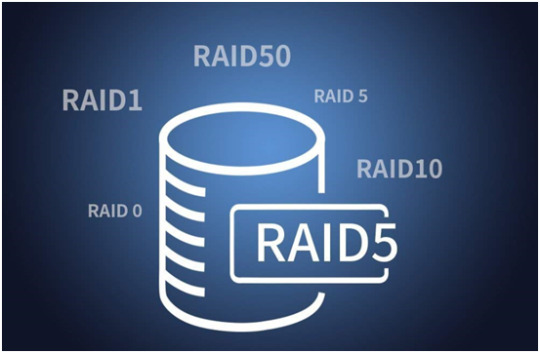
About RAID
RAID is an acronym for Redundant Array of Independent Disks.
RAID is a data storage virtualization technology that combines multiple physical disk drive components into one or more logical units for the purposes of data redundancy, performance improvement, or both.
Data is distributed across the drives in one of several ways, referred to as RAID levels, depending on the required level of redundancy and performance. The different schemes, or data distribution layouts, are named by the word "RAID" followed by a number, for example RAID 0 or RAID 1. Each scheme, or RAID level, provides a different balance among the key goals: reliability, availability, performance, and capacity. RAID levels greater than RAID 0 provide protection against unrecoverable sector read errors, as well as against failures of whole physical drives.
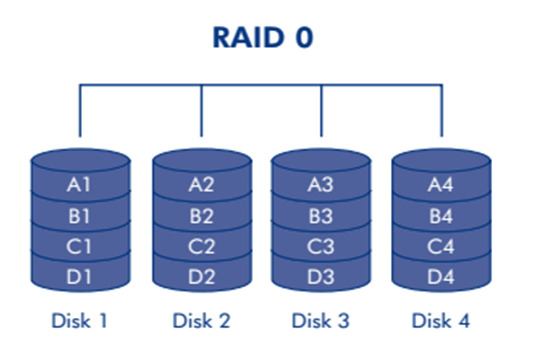
RAID 0 - The fastest transmission speed
RAID 0 consists of striping, but no mirroring or parity.
The capacity of a RAID 0 volume is the same; it is the sum of the capacities of the drives in the set. But because striping distributes the contents of each file among all drives in the set, the failure of any drive causes the entire RAID 0 volume and all files to be lost.
The benefit of RAID 0 is that the throughput of read and write operations to any file is multiplied by the number of drives because, reads and writes are done concurrently.
The cost is increased vulnerability to drive failures—since any drive in a RAID 0 setup failing causes the entire volume to be lost, the average failure rate of the volume rises with the number of attached drives.
RAID 0 does not provide data redundancy but does provide the best performance of any RAID levels.
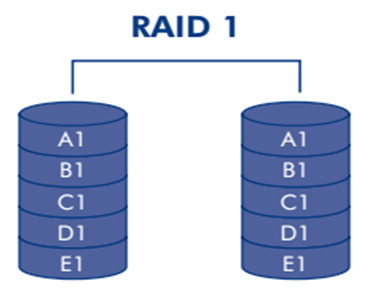
RAID 1 - Data protection is the safest
RAID1 is data protection mode (Mirrored Mode). Half of the capacity is used to store your data and half is used for a duplicate copy. RAID 1 consists of data mirroring, without parity or striping. Data is written identically to two or more drives,If one drive goes down your data is protected because it's duplicated. The array continues to operate as long as at least one drive is functioning.
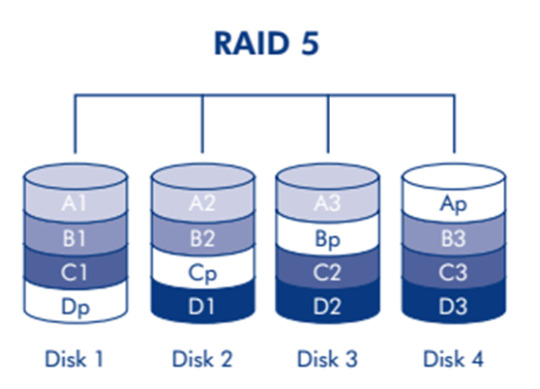
RAID 5 - Best fit Data protection and transmission
RAID 5 consists of block-level striping with distributed parity.
RAID 5 requires at least three disks. In systems with four drives we recommend that you set the system to RAID 5. This gives you the best of both worlds: fast performance by striping data across all drives; data protection by dedicating a quarter of each drive in a four drive system to fault tolerance leaving three quarters of the system capacity available for data storage.
Upon failure of a single drive, subsequent reads can be calculated from the distributed parity such that no data is lost.
The risk is that rebuilding an array requires reading all data from all disks, opening a chance for a second drive failure and the loss of the entire array.

RAID 6 - Large-capacity secure storage RAID6 is more suitable
RAID 6 consists of block-level striping with double distributed parity. Double parity provides fault tolerance up to two failed drives.
RAID 6 requires a minimum of four disks. As with RAID 5, a single drive failure results in reduced performance of the entire array until the failed drive has been replaced.
With a RAID 6 array, using drives from multiple sources and manufacturers, it is possible to mitigate most of the problems associated with RAID 5. The larger the drive capacities and the larger the array size, the more important it becomes to choose RAID 6 instead of RAID 5.
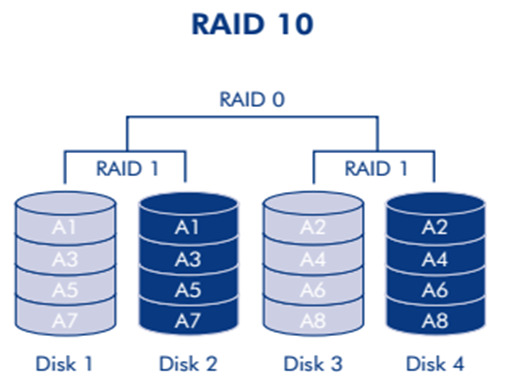
RAID 10 - High reliability and performance
RAID 10, also called RAID 1+0 . RAID 10 is a stripe of mirrors.
Arrays of more than four disks are also possible. A system set to RAID 10 yields half the total capacity of all the drives in the array.
RAID 10 provides better throughput and latency than all other RAID levels except RAID 0. This RAID mode is good for business critical database management solutions that require maximum performance and high fault tolerance. Thus, it is the preferable RAID level for I/O-intensive applications such as database, email, and web servers, as well as for any other use requiring high disk performance.
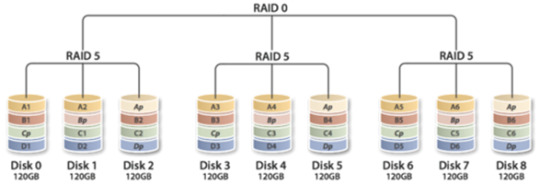
RAID 50 - High reliability and performance
RAID 50, also called RAID 5+0, combines the straight block-level striping of RAID 0 with the distributed parity of RAID 5. As a RAID 0 array striped across RAID 5 elements, minimal RAID 50 configuration requires six drives.
One drive from each of the RAID 5 sets could fail without loss of data; for example, a RAID 50 configuration including three RAID 5 sets can tolerate three maximum potential simultaneous drive failures (but only one per RAID 5 set).
RAID 50 improves upon the performance of RAID 5 particularly during writes, and provides better fault tolerance than a single RAID level does. This level is recommended for applications that require high fault tolerance, capacity and random access performance.
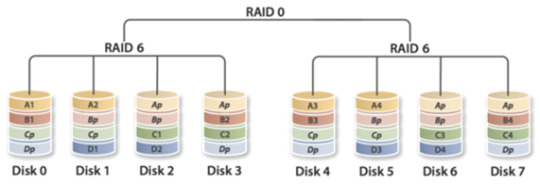
RAID 60 - High reliability and performance
RAID 60, also called RAID 6+0, combines the straight block-level striping of RAID 0 with the distributed double parity of RAID 6, resulting in a RAID 0 array striped across RAID 6 elements. It requires at least eight disks.
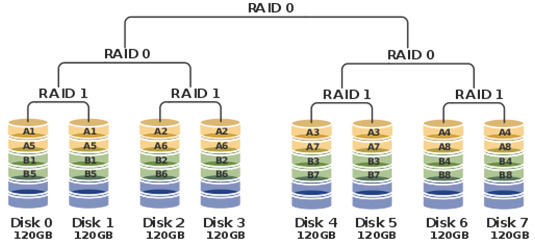
RAID 100 - High reliability and performance
RAID 100, sometimes also called RAID 10+0, is a stripe of RAID 10s. This is logically equivalent to a wider RAID 10 array, but is generally implemented using software RAID 0 over hardware RAID 10. Being "striped two ways", RAID 100 is described as a "plaid RAID".
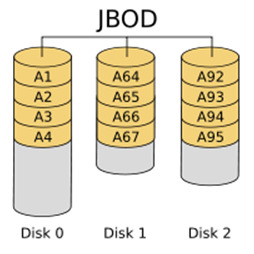
JBOD (Just a Bunch Of Disks)
JBOD (abbreviated from "Just a Bunch Of Disks",also is known as "None RAID") is an architecture using multiple hard drives exposed as individual devices. Hard drives may be treated independently or may be combined into one or more logical volumes using a volume manager like LVM or mdadm, or a device-spanning filesystem like btrfs; such volumes are usually called SPAN or BIG.
A spanned volume provides no redundancy, so failure of a single hard drive amounts to failure of the whole logical volume.
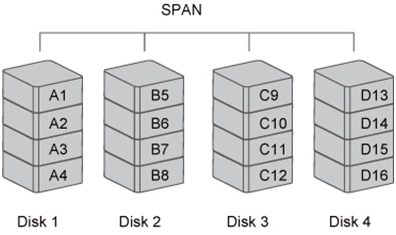
Concatenation (SPAN, BIG, LARGE)
Concatenation or spanning of drives is not one of the numbered RAID levels, but it is a popular method for combining multiple physical disk drives into a single logical disk. It provides no data redundancy.
Spanning provides another maximum capacity solution, which some call it as "Big/Large". Spanning combines multiple hard drives into a single logical unit. Unlike Striping, Spanning writes data to the first physical drive until it reaches full capacity. When the first disk reaches full capacity, data is written to the second physical disk. Spanning provides the maximum possible storage capacity, but does not increase performance.
What makes a SPAN or BIG different from RAID configurations is the possibility for the selection of drives. While RAID usually requires all drives to be of similar capacity and it is preferred that the same or similar drive models are used for performance reasons, a spanned volume does not have such requirements. The advantage of using this mode is that you can add more drives without having to reformat the system.
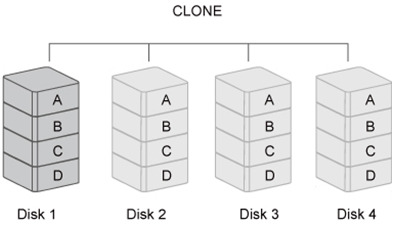
Clone
CLONE consists of at least two drives storing duplicate copies of the same data. In this mode, the data is simultaneously written to two or more disks. Thus, the storage capacity of the disk array is limited to the size of the smallest disk.
RAID Level Comparison
https://www.terra-master.com/global/products.html

#raid#raid1#raid0#raid5#raid6#raid10#raid50#jbod#span#clone#terramaster#raid storage#nas#network storage
3 notes
·
View notes
Text
RAID0のメンバディスクのパーティションが壊れた
なぜかわからんけど、サーバのRAID0を組んでいるメンバディスクの1本が、GPT情報が壊れて、アレイから外れてしまった。
以下、復旧ログ
testdiskで、対象のメンバディスクをAnalyze
実際に削除したパーティションなど、いろんなパーティション情報が出てくるので、全てD(elete)
本当は、RAIDのパーティション情報がディスクの全領域に対してあるはずなのに、最初の8セクタしかない(多分最初にfdiskで無理やりフォーマット情報を上書きしたから・・・)ので、正しいセクタ情報をAddする
8セクタしかないRAIDパーティションもD(elete)
その後、Write → Quit → QuitのあとにReboot
fdisk で対象のメンバディスクをp、他のメンバディスクと同じパーティション情報に戻っていることを確認
この後、mdadmでメンバディスクを再登録しようと思ったけど、怖いのでdebianのインストールディスクを使って、再度OSセットアップ → RAID設定を確認予定
追記 結果、パリティが壊れてたっぽい やむなく、データ消去・・・とほほ
0 notes
